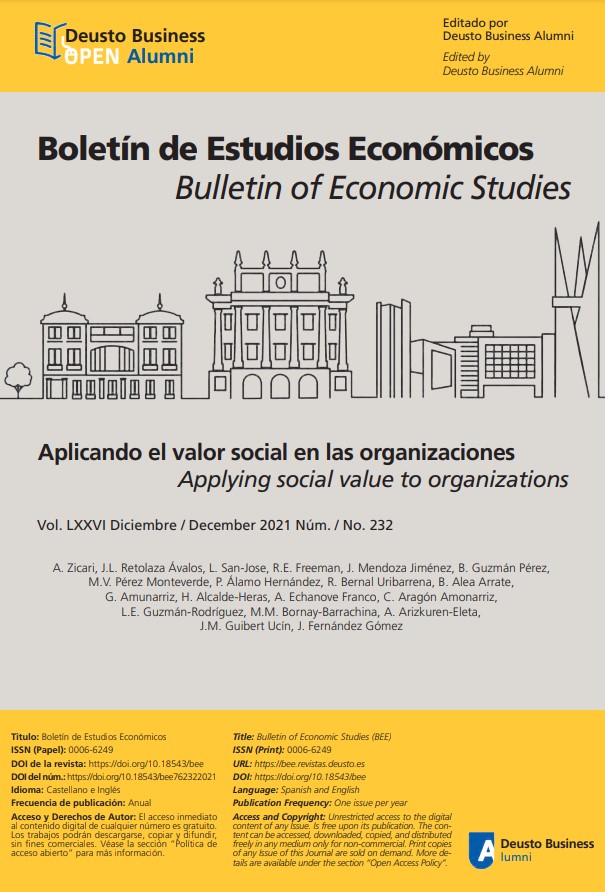Lessons learned about cultural change and managerial skills for the generation of socio-health contexts favorable to people-centered care (PCC)
Abstract
the literature and experience reflect the difficulty in generalizing a cultural change in long-term care organizations. This research focuses on managerial attempts to scale up the good practices generated in the “Etxean Ondo” pilot project. Through a qualitative and constructivist approach, based on grounded theory and action research, the objective of this article is to share those organizational keys and managerial competencies identified in the process of organizational change towards service models based on the Person-Centered Care framework (PCC). In addition to a conceptual contribution, this article includes a set of practical recommendations that the research identifies as key managerial enablers in the development of an organizational context favourable to the PCC: i) actions related to informal organization (intersubjective dimension); ii) actions related to Participating Persons (subjective dimension); iii) actions related to the formal organization (objective dimension). The nature of this study is exploratory, but the emerging results are expected to provide elements for reflection to other managers interested in undertaking an organizational transformation.
Received: 29 October 2021
Accepted: 25 January 2022
References
Abadie, F., Codagnone, C., Lupiáñez-Villanueva, F., & Helter, T. (2014). Strategic intelligence monitor on personal health systems Phase 3 (SIMPHS 3)-Report on the methodological set-up for the SIMPHS3 research. JRC Working Papers, (JRC92703).
Adelman, C. (1993). Kurt Lewin and the origins of action research. Educational Action Research, 1(1), 7-24. DOI: https://doi.org/10.1080/0965079930010102.
Amelung, V., Chase, D., & Reichert, A. (2017). Leadership in integrated care. In Handbook Integrated Care (pp. 221-236). Springer, Cham.
Amunarriz, G. (2020). Fundamentos del liderazgo y gestión estratégica hacia organizaciones sociosanitarias centradas en las personas: una aproximación desde el estudio del caso. Tesis doctoral con mención industrial. Deusto Business School, Universidad de Deusto, Donostia.
Amunarriz, G., & Alcalde-Heras, H. (2020). Towards an integrated care organisation from a CEO perspective. International Journal of Integrated Care, 20(3).
Argandoña, A. (2008). Integrating ethics into action theory and organizational theory. Journal of Business Ethics, 78(3), 435-446. DOI: https://doi.org/10.1007/s10551-006-9340-x.
Bartelings JA, Goedee J, Raab J, Bijl R. (2017). The nature of orchestrational work. Public Management Review, Mar 16; 19(3): 342-60. DOI: https://doi.org/10.1080/14719037.2016.1209233.
Batras, D., Duff, C., & Smith, B. J. (2016). Organizational change theory: implications for health promotion practice. Health Promotion International, 31(1), 231-241. DOI: https://doi.org/10.1093/heapro/dau098.
Bengoa R., .Stout A., Scott B., Mcalinden M., Taylor Ma. (2019). Systems, not structures: changing health & social care. Expert Panel Report for the Ministry of Health of Northern Ireland. Belfast; 2016. Accessed 26 August. https://www.health-ni.gov.uk/publications/systems-not-structures-changinghealth-and-social-care-full-report.
Bernard, P. (1999). Social cohesion: a critique. Canadian Policy Research Networks.
Binns, J. (2008). The ethics of relational leading: gender matters. Gender, Work and Organization, 15(6), 600-620. DOI: https://doi.org/10.1111/j.1468-0432.2008.00418.x.
Birkinshaw, J., Zimmermann, A., & Riasch, S. (2016). How do firms adapt to discontinuous change? California Management Review, 58(4), 36-58. DOI: https://doi.org/10.1525/cmr.2016.58.4.36.
Bishop, C. E. (2014). High-performance workplace practices in nursing homes: an economic perspective. Gerontologist, 54(suPPl 1), 46-52. DOI: https://doi.org/10.1093/geront/gnt163.
Brownie, S., & Nancarrow, S. (2013). Effects of person-centered care on residents and staff in aged-care facilities: a systematic review. Clinical Interventions in Aging, 8, 1-10. DOI: https://doi.org/10.2147/CIA.S38589.
Busetto L, Luijkx K, Calciolari S, Ortiz Lgg, Vrijhoef Hjm. (2018). Barriers and facilitators to workforce changes in integrated care. International Journal of Integrated Care, 18(2): 17. DOI: https://doi.org/10.5334/ijic.3587.
Butterfield, J. (2009). Using grounded theory and action research to raise attainment in, and enjoyment of, reading. Educational Psychology in Practice, 25(4), 315- 326. DOI: https://doi.org/10.1080/02667360903315131.
Chinchilla, N., & Cruz, H. (2011). Diversidad y paradigmas de empresa: un nuevo enfoque. Revista Empresa y Humanismo, 47-79.
Coghlan, D. (2007). Insider action research doctorates: generating actionable knowledge. Higher Education, 54(2), 293-306. DOI: https://doi.org/10.1007/s10734-005-5450-0.
Cooney, A. (2012). «Finding home»: a grounded theory on how older people «find home» in long-term care settings. International Journal of Older People Nursing, 7(3), 188-199. DOI: https://doi.org/10.1111/j.1748-3743.2011.00278.x.
Cristofoli D., Meneguzzo M., Riccucci N. (2016). Collaborative administration: the management of successful networks. Public Management Review, 2017: 275- 283. DOI: https://doi.org/10.1080/14719037.1209236.
Cuñat Giménez, R. J. (2007). Aplicación de la teoría fundamentada. Decisiones Globales, 1-13.
Eisenhardt, K.M., & Martin, J. A. (2000). Dynamic capabilities: what are they? Strategic Management Journal, 21(10-11), 1105-1121.
Fillingham, D, Weir B. (2014). System leadership: lessons and learning from AQuA’s integrated care discovery communities. London: King’s Fund; October. https://www.kingsfund.org.uk/sites/default/files/field/field_publication_file/system-leadership-october-2014.pdf.
Glaser, B G, Strauss, Al. (2017). Discovery of grounded theory: Strategies for qualitative research. Routledge.
González-Ortiz L.G., Calciolari S., Goodwin N., Stein V. (2018). The core dimensions of integrated care: A literature review to support the development of a comprehensive framework for implementing integrated care. Int J Integr Care, Aug 8; 18(3): 10. DOI: https://doi.org/10.5334/ijic.4198.
Goodwin N. (2017). Change management. In Amelung VE, Stein KV, Goodwin N, Balicer R, Nolte E, Suter E (eds.). Handbook Integrated Care. New York: Springer Nature. DOI: https://doi.org/10.1007/978-3-319-56103-5_1.
Gray, C.S., Tang, T., Armas, A., Backo-Shannon, M., Harvey, S., Kuluski, K., & Nelson, M. (2020). Building a digital bridge to support patient-centered care transitions from hospital to home for older adults with complex care needs: protocol for a co-design, implementation, and evaluation study. JMIR Research Protocols, 9(11), e20220.
Gummesson, E. (2000). Qualitative research in management. Qualitative Methods in Management Research, 212. DOI: https://doi.org/10.1016/j.ijproman.2012.11.012.
Hahn, T., Pinkse, J., Preuss, L., & Figge, F. (2015). Tensions in corporate sustainability: towards an integrative framework. Journal of Business Ethics, 127(2), 297-316. DOI: https://doi.org/10.1007/s10551-014-2047-5.
Ham, C., Walsh N. (2013). Making integrated care happen at scale and pace: lessons from experience. London: the King’s Fund. https://www.kingsfund.org.uk/publications/making-integrated-care-happen-scale-and-pace.
Heimans, J., Timms, H. (2014). Understanding “new power”. Harvard Business Review, December. https://hbr.org/2014/12/understanding-new-power.
Joa I, Testad I, Leiknes I, Severinsson E, Rørtveit K, Sætre B (2015). Patients’ experiences of trust in the patient-nurse relationship—A systematic review of qualitative studies. Open Journal of Nursing. 05(03): 195-209. DOI: https://doi.org/10.4236/ojn.2015.53024.
Kadu MK, Stolee P. (2015). Facilitators and barriers of implementing the chronic care model in primary care: a systematic review. BMC Fam Pract, Feb 6; 16(12). DOI: https://doi.org/10.1186/s12875-014-0219.
Kitson, A., Marshall, A., Bassett, K., & Zeitz, K. (2013). What are the core elements of patient-centred care? A narrative review and synthesis of the literature from health policy, medicine and nursing. Journal of Advanced Nursing, 69(1), 4-15.
Koren, M. J. (2010). Person-centered care for nursing home residents: the culturechange movement. Health Affairs, 29(2), 312-317. DOI: https://doi.org/10.1377/hlthaff.2009.0966.
Laurola, H. E. (2018). Integrated care in action: a practical guide for health, social care and housing support: Robin Miller, Hilary Brown and Catherine Mangan, London: Jessica Kingsley Publishers, 2016, pp 232, ISBN: 978-1- 84905-646-5 (paperback). International Journal of Integrated Care, 18(3).
Leutz, W., Bishop, C. E., & Dodson, L. (2010). Role for a labor-management partnership in nursing home person-centered care. The Gerontologist, 50(3), 340-351.
Levinthal, D. A., & March, J. G. (1993). The myopia of learning. Strategic Management Journal, 14(2 s), 95-112. DOI: https://doi.org/10.1002/smj.4250141009.
Lewin, K. (1943). Defining the ‘field at a given time’. Psychological Review, 50(3), 292.
Mccormarck B, Mccance, T (2017). Person-centred in nursing and Health care: theory and practice, 2nd edition. Wiley Blackwell, Oxford.
Mertens, D. M. (2008). Transformative research and evaluation. Guilford Press.
Miller, R. (2018). Transforming integration through general practice: learning from a UK Primary Care Improvement Programme. Int J Integr Care, Apr-Jun; 18(2): 13. DOI: https://doi.org/10.5334/ijic.3044.
Miller, R., & Stein, K. V. (2020). The odyssey of integration: is management its achilles’ heel?. International Journal of Integrated Care, 20(1).
Minkman, M. (2016). The development model for integrated care: a validated tool for evaluation and development. Journal of Integrated Care; 24(1): 38-52. DOI: https://doi.org/10.1108/JICA-01-2016-0005.
Mintzberg, H. (2017). Managing the myths of health care. bridging the separations between care, cure, control, and community. Oakland: Berrett- Koehler Publishers. DOI: https://doi.org/10.1007/978-3-319-53600-2_1.
Mitterlechner, M. (2020). Leadership in integrated care networks: A literature review and opportunities for future research. International Journal of Integrated Care, 20(3).
Nonaka, I. (1994). A Dynamic theory of organizational knowledge creation. Knowledge, Groupware and the Internet, 5(1), 3-42. DOI: https://doi.org/10.1016/b978-0-7506-7111-8.50003-2.
Nooteboom, B. (2000). Learning by interaction: Absorptive capacity, cognitive distance and governance. Journal of Management and Governance, 4(1-2), 69-92. DOI: https://doi.org/10.1023/A:1009941416749.
Pérez- López, J.A. (1993). Fundamentos de la dirección de empresas. Manuales Universitarios. Ediciones Rialp.
Romano, S. A., Klocker, N., Herr, K., & Anderson, G. L. (2005). Slaying my own ghosts: my process into action research. Journal of Geography in Higher Education, 36(1), 149-163. DOI: https://doi.org/10.1080/03098265.2011.589828.
Rosengren, K. (2016). Person-centred care: A qualitative study on first line managers’ experiences on its implementation. Health Services Management Research. 29(3): 42-49. DOI: https://doi.org/10.1177/0951484816637748.
Sancho, M. (2014). Estudio sobre las condiciones de vida de las personas mayores en Euskadi. Gizartea Hobetuz Documentos de Bienestar Social.
Sjögren, K., Lindkvist, M., Sandman, P. O., Zingmark, K., & Edvardsson, D. (2017). Organisational and environmental characteristics of residential aged care units providing highly person-centred care: A cross sectional study. BMC Nursing, 16(1), 1-9. DOI: https://doi.org/10.1186/s12912-017-0240-4.
Solansky, S. T. (2008). Leadership style and team processes in self-managed teams. Journal of Leadership and Organizational Studies, 14(4), 332-341. DOI: https://doi.org/10.1177/1548051808315549.
Stein, K.V. (2016). Developing a competent workforce for integrated health and social care: What does it take? International Journal of Integrated Care; 16(4): 9. DOI: https://doi.org/10.5334/ijic.2533.
Weick, K. E., Sutcliffe, K. M., & Obstfeld, D. (2005). Organizing and the process of sensemaking. Organization Science, 16(4), 409-421.
WHO Europe. (2016). EUR/RC66/15 strengthening people-centred health systems in the WHO European Region: framework for action on integrated health services delivery. copenhagen: WHO Regional Office for Europe. http://www.euro.who.int/en/health-topics/Health-systems/pages/publications/2016/eurrc6615-strengthening-people-centred-health-systems-in-the-who-european-region-frameworkfor-action-on-integrated-health-services-delivery.
Zonneveld N., Driessen N., Stüssgen Ra., Minkman Mm. (2018). Values of integrated care: A systematic review. International Journal of Integrated Care, Oct-Dec; 18(4): 9. DOI: https://doi.org/10.5334/ijic.4172.
License:
Works published in this journal are available since 2021 under the Creative Commons Attribution-NonCommercial 4.0 International license - CC BY-NC 4.0. Content prior to 2021 is not covered by the journal's current Open Access policy.
Authors' Rights:
Authors retain copyright over their work published in the Bulletin of Economic Studies and grant the Bulletin of Economic Studies non-exclusive rights to exploit the work for layout, publication, and dissemination purposes. This license allows the Bulletin of Economic Studies to distribute, reproduce, and disseminate the work on its platform and through other media, subject to the conditions outlined in this notice.
Readers' Rights:
Readers may read, download, print, search, share (copy, redistribute, or link to full text), or adapt (remix, transform, and build upon the material) the content, provided that:
- The materials are not used for commercial purposes.
- The original work is properly cited, including the name of the author and the source.
- Any modifications made to the original content are clearly indicated.
Commercial use of the materials is prohibited without the express permission of the authors. For clarity, commercial use is defined as any activity intended for financial gain or involving direct commercial exchange.
Conditions of Use:
The use of content must not infringe the rights of others or be used in a way that could damage the reputation of the author or the Bulletin of Economic Studies.
Responsibility for Content:
Authors are responsible for the content of their papers and the Bulletin of Economic Studies is not responsible for the opinions therein expressed.
More Information:
Open Access, Licensing, and Copyright Policy


.jpg)
.jpg)
.jpg)








